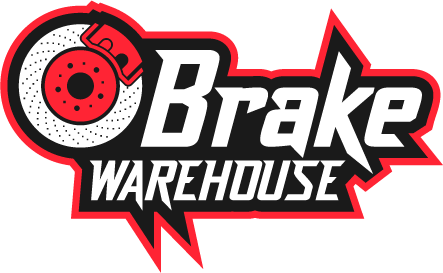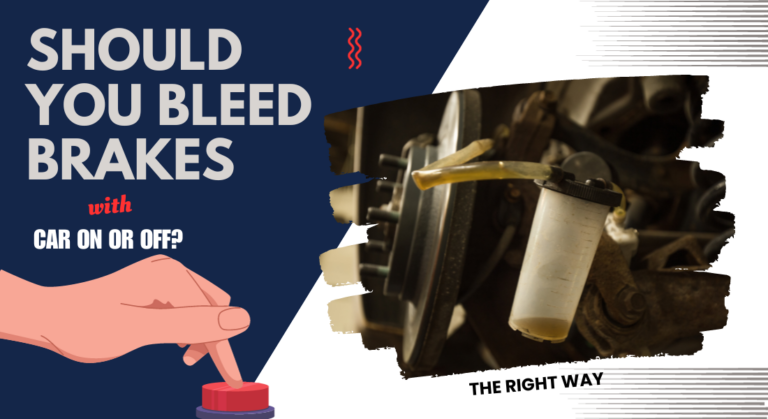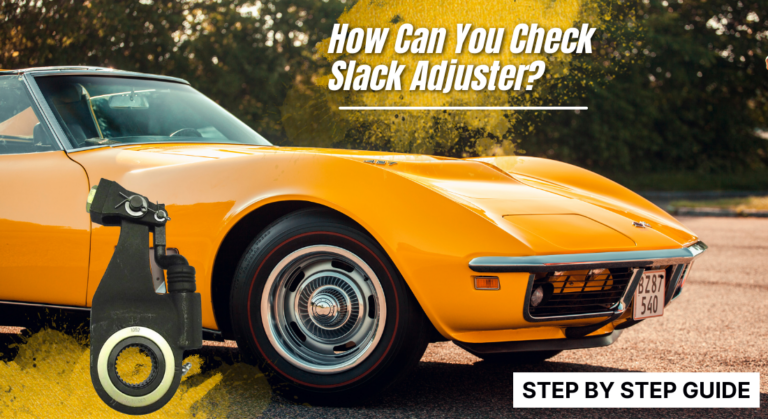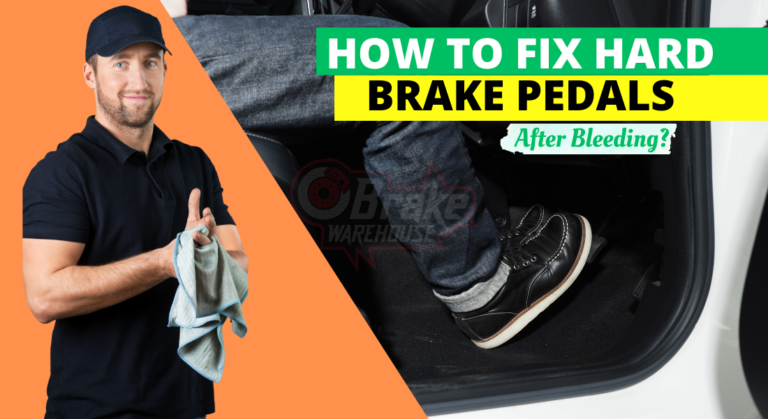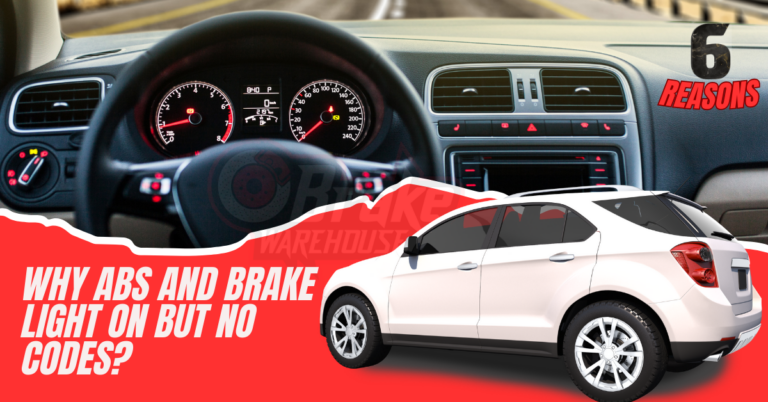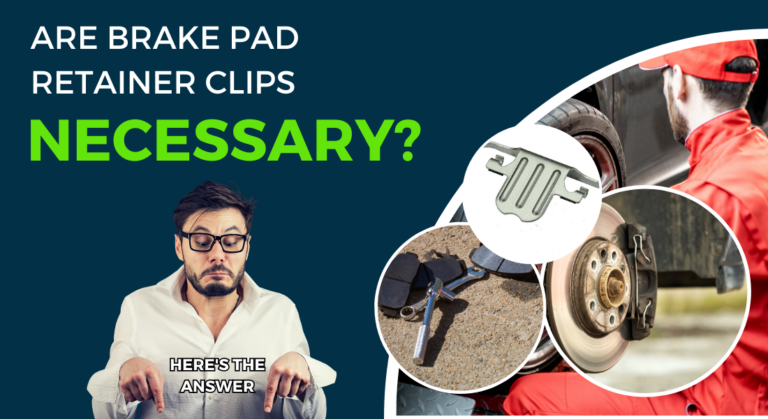Why Do Brakes Squeal When Cold Until Warmed Up?
Squeal is generally a friction-induced noise with a high frequency of more than 1KHz. Some squealing issues are minor and also require a minor repair. Yet, some can be severe enough to cause braking failure and expensive repair.
Generally, brakes squeal when cold until warmed up is a common issue during winter. But, before proceeding with the expensive repair or replacement, understand the causes behind this squealing issue.
In this article, we will discuss the reasons and solutions for this squealing noise issue when your car is cold. Thus, stay with us till the end.

Reasons For Brakes Squeal When Cold Until Warmed Up
There are several reasons why your car’s brakes may squeal when they are cold until they warm up, such as:
- High ceramic content of the brake pad
- Sticking caliper
- Morning rust
- Thickening of brake fluid
- Worn-out brake discs
- Accumulated debris between car rotor and pads
Let’s know more about these causes in detail:
1. High Ceramic Content Brake Pad

You may use ceramic brake pads as they generate less brake dust and are also long-lasting. Yet, unlike metallic brake pads, they are not suitable for cold weather.
These ceramic brake pads will be noisy under their optimal operating temperature. Generally, the inadequate friction below the operating temperature is responsible for the squealing noises.
2. Sticking Caliper

Improper installation may cause the brake caliper to wedge with the rotor. It will force the brake pad to stick continuously against the rotor. As a result, you will hear grinding or squealing noises coming from the brake when the wheel rotates.
After some time, the caliper will be released once the brake gets hot. As a result, the noises will also vanish.
3. Morning Rust

Overnight moisture or condensation during cold weather will cause a thin layer of rust to form on your car’s rotor surface. Then, when you apply brakes, the brake pads may momentarily scrape off this rust layer and will cause noises.
Also, snow can get into the braking components and may freeze under 32°F. Thus, once you start your car, you will hear the noise. Once the braking components of each wheel will warm up enough to melt away the ice, the car will stop squealing.
4. Thickening Of Brake Fluid

Brake fluid can become thicker in colder temperatures, affecting its flow and performance. You will most likely face this issue if you haven’t changed the brake fluid for a long time.
Usually, brake fluid starts to absorb moisture from the air over time. This could contribute to brake squealing until the fluid warms up and regains its optimal viscosity.
5. Wearing Of Brake Discs

If the brake discs wear down or have become warped or unevenly worn, it can cause the brake pads to vibrate.
As a result, it will produce a squealing noise. But, with warming up, the noise will also diminish.
6. Accumulated Debris

Sometimes, dirt or small stones can get trapped between the rotor and pads, which will cause noise upon starting the car.
After running for some time, the dirt and stone can ground between the moving parts and will stop squealing.
Solutions Of Brakes Squeal When Cold Until Warmed Up
The squealing noise can be unpleasant and may sometimes reduce the brake performance. Here are some ways to address this issue yourself:
Replacing Brake Pads

You should replace the ceramic or damaged brake pads. Generally, you must avoid brake pads with high ceramic content; instead, choose ones with metallic content (our recommendation). This type of brake pad is more appropriate for cold weather than those ceramic ones.
Here are the steps for replacing the brake pads:
- Step 1: Make sure the car is cool before starting.
- Step 2: Loosen the lug nuts using a lug wrench and then jack up the car.
- Step 3: Remove the wheel from the car’s body.
- Step 4: Use an appropriate ring spanner to remove the caliper bolts.
- Step 5: After removing the caliper, hang it using a wire cord so it can’t strain the brake hose further.
- Step 6: Release retaining clips or pins to remove the old brake pad from the caliper.
- Step 7: Install a new brake pad following the reverse removal process. Follow the same process for each of the wheels.
- Step 8: Start the vehicle and engage the brake 15-20 times to check the appropriate engagement of the pads.
Bleeding The Brake Fluid

Let’s see how to bleed the car’s brake fluid:
- Step 1: Open the vehicle’s hood, locate the brake fluid reservoir, and open the cap.
- Step 2: Use a Turkey baster to take out the old brake fluid from the reservoir.
- Step 3: Add appropriate brake fluid into the reservoir and close the cap.
- Step 4: You need to check the user manual to understand the order of bleeding the brakes.
- Step 5: Find the bleeder valve on the brake caliper and attach a clear plastic hose to the valve. Another end will be on the fluid collecting drum.
- Step 6: Have a helper press the brake pedal firmly and hold it down.
- Step 7: Open the bleeder valve slightly with a wrench, allowing the old brake fluid to flow into the container. Close the valve before your helper releases the brake pedal.
- Step 8: Repeat the process until clear, bubble-free brake fluid flows steadily through the hose. Ensure the reservoir tank is high during this process.
Check this YouTube video to get a better idea of these steps:
Cleaning The Dirt
You need to remove the car wheel to get access to the braking components. Then, inspect the brake pads, calipers, and rotors for visible dirt or debris buildup.
You can use a wire brush, compressed air, or brake cleaner to eliminate the dirt. After cleaning, reinstall the wheel properly.
Installation Of Brake Shims
While replacing the brake pads, you can also install brake shims for sound reduction. This will act as a permanent damper of vibration and the transmission of vibration from the pads to the vehicle will also reduce. For this, you need to clean the contact surface on the caliper and brake pads.
Then, install the brake shims in between the brake pads and calipers or on the back of the pads like in this figure:
This figure shows the idea of proper alignment of the anti-squeal shims.
Application Of Brake Grease
It is a low-cost solution for brake squealing noises. When you remove the brake pads, you can apply anti-squeal grease onto the pads.
You must apply a thin and uniform layer of grease to the back of the brake pads. Alongside, apply the grease to caliper areas that will come in contact with the pads.
FAQs
In this FAQs section, we will answer several questions about the Squeaking of brakes.
Is My Car’s Brake Sensitive To Cold Weather?
Yes. Your car’s brake system converts the kinetic energy into heat with friction. Thus, the more the heat will create, the more the braking power will be. Hence, in freezing weather, the brake system may lose its performance or may fail.
Can I Drive My Car With This Brake Squealing Issue?
Yes. Though you can drive your car with the squealing, we suggest warming up the car before reaching the highway. Also, you can drive safely if the squealing is occurring due to moisture issues, except for any wearing issues.
What If My Car’s Brake Squealing Persists?
If the brake squealing is persistent, there may be underlying issues with worn-out or damaged brake parts, loose components, etc. Thus, you may need to consult a mechanic and repair or replace the faulty brake parts.
Conclusion
Generally, the brakes squeal when cold until warmed up occurs when you leave the car overnight in the snow. The accumulation of a thin layer of snow inside the braking components is responsible for the noise when you start the car.
Yet, some other reasons, like the wearing down of brake pads or ceramic brake pads, will require the replacement of the brake pads. You can also bleed the brake fluid and use brake shims and grease to reduce or eliminate the squealing issue of your car’s brake.

Meet Zayan, the mechanical genius behind the highly acclaimed brakes problems and solutions website. With over a decade of hands-on experience in the automotive industry, Zayan has become a trusted authority in the realm of brake systems.
His passion for cars, coupled with his expertise in solving complex brake-related issues, has earned him a devoted following of car enthusiasts, mechanics, and everyday drivers seeking reliable guidance.
